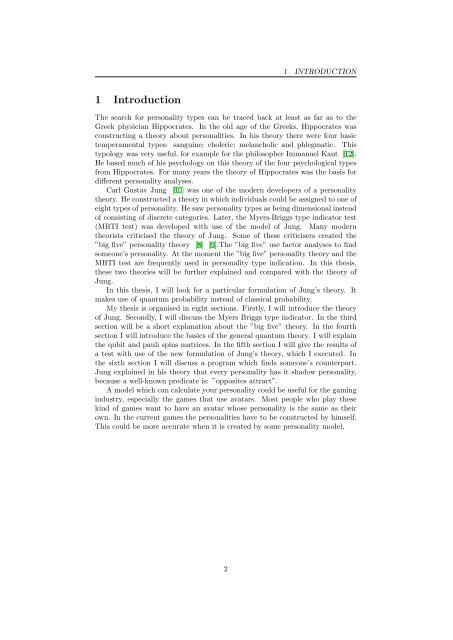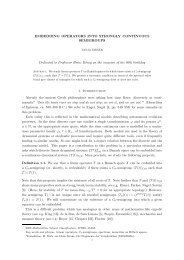Automatic modeling of personality types - Universiteit van Amsterdam
Automatic modeling of personality types - Universiteit van Amsterdam
Automatic modeling of personality types - Universiteit van Amsterdam
You also want an ePaper? Increase the reach of your titles
YUMPU automatically turns print PDFs into web optimized ePapers that Google loves.
1 Introduction<br />
1 INTRODUCTION<br />
The search for <strong>personality</strong> <strong>types</strong> can be traced back at least as far as to the<br />
Greek physician Hippocrates. In the old age <strong>of</strong> the Greeks, Hippocrates was<br />
constructing a theory about personalities. In his theory there were four basic<br />
temperamental <strong>types</strong>: sanguine; choleric; melancholic and phlegmatic. This<br />
typology was very useful, for example for the philosopher Immanuel Kant [12].<br />
He based much <strong>of</strong> his psychology on this theory <strong>of</strong> the four psychological <strong>types</strong><br />
from Hippocrates. For many years the theory <strong>of</strong> Hippocrates was the basis for<br />
different <strong>personality</strong> analyses.<br />
Carl Gustav Jung [10] was one <strong>of</strong> the modern developers <strong>of</strong> a <strong>personality</strong><br />
theory. He constructed a theory in which individuals could be assigned to one <strong>of</strong><br />
eight <strong>types</strong> <strong>of</strong> <strong>personality</strong>. He saw <strong>personality</strong> <strong>types</strong> as being dimensional instead<br />
<strong>of</strong> consisting <strong>of</strong> discrete categories. Later, the Myers-Briggs type indicator test<br />
(MBTI test) was developed with use <strong>of</strong> the model <strong>of</strong> Jung. Many modern<br />
theorists criticised the theory <strong>of</strong> Jung. Some <strong>of</strong> these criticisers created the<br />
”big five” <strong>personality</strong> theory [8] [9].The ”big five” use factor analyses to find<br />
someone’s <strong>personality</strong>. At the moment the ”big five” <strong>personality</strong> theory and the<br />
MBTI test are frequently used in <strong>personality</strong> type indication. In this thesis,<br />
these two theories will be further explained and compared with the theory <strong>of</strong><br />
Jung.<br />
In this thesis, I will look for a particular formulation <strong>of</strong> Jung’s theory. It<br />
makes use <strong>of</strong> quantum probability instead <strong>of</strong> classical probability.<br />
My thesis is organised in eight sections. Firstly, I will introduce the theory<br />
<strong>of</strong> Jung. Secondly, I will discuss the Myers Briggs type indicator. In the third<br />
section will be a short explanation about the ”big five” theory. In the fourth<br />
section I will introduce the basics <strong>of</strong> the general quantum theory. I will explain<br />
the qubit and pauli spins matrices. In the fifth section I will give the results <strong>of</strong><br />
a test with use <strong>of</strong> the new formulation <strong>of</strong> Jung’s theory, which I executed. In<br />
the sixth section I will discuss a program which finds someone’s counterpart.<br />
Jung explained in his theory that every <strong>personality</strong> has it shadow <strong>personality</strong>,<br />
because a well-known predicate is: ”opposites attract”.<br />
A model which can calculate your <strong>personality</strong> could be useful for the gaming<br />
industry, especially the games that use avatars. Most people who play these<br />
kind <strong>of</strong> games want to have an avatar whose <strong>personality</strong> is the same as their<br />
own. In the current games the personalities have to be constructed by himself.<br />
This could be more accurate when it is created by some <strong>personality</strong> model.<br />
2

















